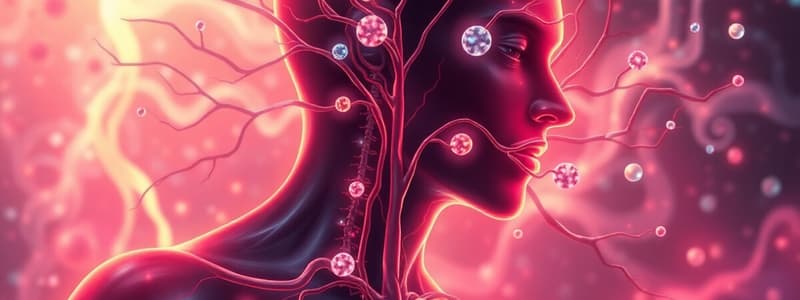Podcast
Questions and Answers
Which type of drug is used to treat asthma by mimicking the effects of adrenaline and noradrenaline?
Which type of drug is used to treat asthma by mimicking the effects of adrenaline and noradrenaline?
- Sympathomimetic (correct)
- Parasympathomimetic
- Parasympatholytic
- Sympatholytic
A medication that blocks muscarinic receptors would be classified as which of the following?
A medication that blocks muscarinic receptors would be classified as which of the following?
- Sympathomimetic
- Beta Agonist
- Cholinergic Agonist
- Anti-Muscarinic (correct)
Which of these best describes the mechanism of action for a sympatholytic drug?
Which of these best describes the mechanism of action for a sympatholytic drug?
- Blockage of all cholinergic receptors
- Blockage of adrenergic receptors (correct)
- Stimulation of the parasympathetic nervous system
- Activation of muscarinic receptors
If a patient takes a medication that increases salivation, which type of receptor is most likely being affected?
If a patient takes a medication that increases salivation, which type of receptor is most likely being affected?
Which drug class is associated with the treatment of overactive bladder?
Which drug class is associated with the treatment of overactive bladder?
A medication that is described as a 'beta-blocker' belongs to which category of drugs?
A medication that is described as a 'beta-blocker' belongs to which category of drugs?
If a drug is described as 'pertaining to the actions of acetylcholine,' which of the following classifications would it most closely fit?
If a drug is described as 'pertaining to the actions of acetylcholine,' which of the following classifications would it most closely fit?
Which of the following best describes the function of a parasympathomimetic drug?
Which of the following best describes the function of a parasympathomimetic drug?
Which medication primarily activates beta-2 adrenergic receptors?
Which medication primarily activates beta-2 adrenergic receptors?
Atenolol is primarily known for which action?
Atenolol is primarily known for which action?
What is the primary mechanism of action for beta-antagonists?
What is the primary mechanism of action for beta-antagonists?
Which of these medications is not used to treat heart conditions?
Which of these medications is not used to treat heart conditions?
What does a 'Sympathomimetic' drug do?
What does a 'Sympathomimetic' drug do?
What of the following is a primary use of a beta agonist?
What of the following is a primary use of a beta agonist?
What receptor type is primarily blocked by Propranolol?
What receptor type is primarily blocked by Propranolol?
Which drug class works by blocking muscarinic receptors?
Which drug class works by blocking muscarinic receptors?
Which classes of drugs are used to modulate the autonomic nervous system?
Which classes of drugs are used to modulate the autonomic nervous system?
Which drug class primarily inhibits the activity of the sympathetic nervous system?
Which drug class primarily inhibits the activity of the sympathetic nervous system?
Which drug class primarily inhibits the parasympathetic nervous system?
Which drug class primarily inhibits the parasympathetic nervous system?
Flashcards
Sympathomimetic (Adrenergic Agonists)
Sympathomimetic (Adrenergic Agonists)
Drugs that stimulate the sympathetic nervous system (SNS) by mimicking the effects of adrenaline and noradrenaline. They activate adrenergic receptors (alpha and beta receptors).
Sympatholytic (Anti-Adrenergic or Adrenergic Antagonists)
Sympatholytic (Anti-Adrenergic or Adrenergic Antagonists)
Drugs that inhibit the SNS by blocking the effects of adrenaline and noradrenaline. They work by blocking adrenergic receptors (alpha and beta receptors).
Parasympathomimetic (Cholinergic Agonists)
Parasympathomimetic (Cholinergic Agonists)
Drugs that stimulate the parasympathetic nervous system (PNS) by mimicking the effects of acetylcholine. They activate muscarinic or nicotinic receptors.
Parasympatholytic (Anti-Cholinergic or Anti-Muscarinic)
Parasympatholytic (Anti-Cholinergic or Anti-Muscarinic)
Signup and view all the flashcards
Beta Agonists (Beta-Adrenergic Agonists)
Beta Agonists (Beta-Adrenergic Agonists)
Signup and view all the flashcards
Anti-Muscarinic (Muscarinic Antagonists)
Anti-Muscarinic (Muscarinic Antagonists)
Signup and view all the flashcards
Cholinergic (Related to Acetylcholine)
Cholinergic (Related to Acetylcholine)
Signup and view all the flashcards
Muscarinic (Related to Muscarinic Receptors)
Muscarinic (Related to Muscarinic Receptors)
Signup and view all the flashcards
Sympatholytic (Anti-Adrenergic)
Sympatholytic (Anti-Adrenergic)
Signup and view all the flashcards
Parasympatholytic (Anti-Cholinergic)
Parasympatholytic (Anti-Cholinergic)
Signup and view all the flashcards
Beta Agonists
Beta Agonists
Signup and view all the flashcards
Beta Antagonists (Beta Blockers)
Beta Antagonists (Beta Blockers)
Signup and view all the flashcards
What are Beta-2 agonists used for?
What are Beta-2 agonists used for?
Signup and view all the flashcards
What are Beta-1 agonists used for?
What are Beta-1 agonists used for?
Signup and view all the flashcards
Study Notes
Autonomic Nervous System Drug Classes
-
Sympathomimetic (Adrenergic Agonists):
- Definition: Mimic the sympathetic nervous system, using adrenaline and noradrenaline.
- Mechanism: Activate alpha and beta receptors.
- Examples: Epinephrine, Albuterol, Dobutamine.
- Uses: Asthma, cardiac arrest, and hypotension.
-
Sympatholytic (Anti-Adrenergic or Adrenergic Antagonists):
- Definition: Inhibit the sympathetic nervous system by blocking adrenaline and noradrenaline effects.
- Mechanism: Block alpha and beta receptors.
- Examples: Propranolol (beta-blocker) and clonidine (alpha-2 agonist).
- Uses: Hypertension, anxiety, and heart arrhythmias.
-
Parasympathomimetic (Cholinergic Agonists):
- Definition: Mimic the parasympathetic nervous system, using acetylcholine.
- Mechanism: Activate muscarinic or nicotinic receptors.
- Examples: Pilocarpine, Bethanechol.
- Uses: Glaucoma and urinary retention.
-
Parasympatholytic (Anti-Cholinergic or Anti-Muscarinic):
- Definition: Inhibit the parasympathetic nervous system by blocking acetylcholine.
- Mechanism: Block muscarinic receptors.
- Examples: Atropine, Ipratropium.
- Uses: Bradycardia, reduce salivation, and manage COPD.
-
Cholinergic (Related to Acetylcholine):
- Definition: Pertaining to the actions of acetylcholine.
- Mechanism: Involves muscarinic or nicotinic receptors.
- Examples: Acetylcholine, Nicotine.
- Uses: Same as parasympathomimetics.
-
Anti-Muscarinic (Muscarinic Antagonists):
- Definition: Block muscarinic acetylcholine receptors, inhibiting the parasympathetic nervous system (PNS).
- Mechanism: Compete with acetylcholine for muscarinic receptors.
- Examples: Scopolamine, oxybutynin.
- Uses: Treat motion sickness, overactive bladder.
-
Muscarinic (Related to Muscarinic Receptors):
- Definition: Relating to muscarinic receptors, a type of cholinergic receptor.
- Mechanism: Activated by acetylcholine.
- Examples: Muscarine (fungi), bethanechol.
- Uses: Stimulate PNS actions (e.g., increasing salivation, bladder contraction).
-
Beta Agonists (Beta-Adrenergic Agonists):
- Definition: Drugs stimulating beta-adrenergic receptors.
- Mechanism: Activate beta-1, beta-2, or beta-3 receptors.
- Examples: Albuterol (beta-2), dobutamine (beta-1).
- Uses: Asthma, heart failure (increasing cardiac output).
-
Beta Antagonists (Beta Blockers):
- Definition: Block beta-adrenergic receptors.
- Mechanism: Inhibit beta-1, beta-2, or beta-3 receptors.
- Examples: Propranolol (non-selective), atenolol (beta-1 selective).
- Uses: Hypertension, angina, and heart arrhythmias.
Studying That Suits You
Use AI to generate personalized quizzes and flashcards to suit your learning preferences.
Related Documents
Description
Explore the different drug classes affecting the autonomic nervous system. This quiz covers sympathomimetic, sympatholytic, parasympathomimetic, and parasympatholytic drugs, their mechanisms, examples, and clinical uses. Perfect for students of pharmacology and medicine!



